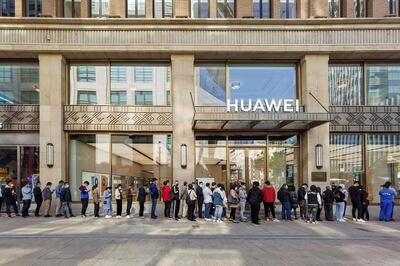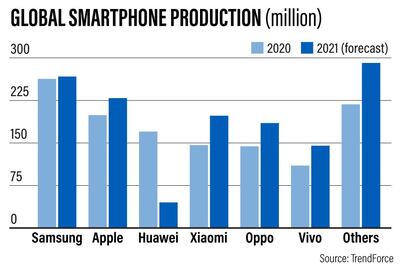Global smartphone production is projected to increase by almost 9 per cent to 1.36 billion units in 2021, after it fell 11 per cent year-on-year in 2020 amid the pandemic-induced economic slowdown, according to a new report.
Only1.25 billion smartphones were produced globally last year, as Covid-19 hit discretionary spending and upended supply chains of phone manufacturers, Taipei-based market intelligence firm TrendForce said in its latest findings.
“Market will gradually recover as people become accustomed to the new normal resulting from the pandemic,” it said
This year will see a “strong wave of device replacement demand” as well as “demand growth in the emerging markets”.
South Korean manufacturer Samsung led the industry with almost 21 per cent market share in 2020, producing 263 million handsets last year. It was followed by the US technology giant Apple, which made 199 million handsets, and Chinese brand Huawei, with 170 million handsets, grabbing 16 per cent and 14 per cent market share, respectively.
Shenzhen-based Huawei, which for the first time reached the number one position in the smartphone industry with 20 per cent market share in the second quarter of last year, is expected to see a significant decline in smartphone manufacturing this year.
Its inability to secure enough crucial components and software needed to manufacture smartphones and US restrictions on the company, will drive down production. TrendForce predicts Huawei to slip from the third place in 2020 to the seventh spot this year.
“This is because of the effects of the US export restrictions and the spin-off of Honor as a separate entity operating in the smartphone market,” it said.
Last November, Huawei sold its Honor smartphone business to a Chinese government-backed consortium for an undisclosed amount.
The top six smartphone makers in 2021 will be Samsung, Apple, Xiaomi, Oppo, Vivo, and Transsion. Together, they will account for almost 80 per cent of the global smartphone market.
Looking forward, the research firm said the Covid-19 pandemic will remain the “central variable or the biggest uncertainty” in the smartphone industry.
“It will continue to exert significant influence on the global economy. Besides the pandemic, the performance of smartphone brands during 2021 could also be affected by geopolitical instabilities and the lack of available production capacity in the semiconductor foundry market,” it added.
With the wider rollout of fifth-generation network expected this year, the penetration rate of 5G smartphones is likely to rise to 37 per cent in 2021, to about 500 million units.
“Thanks to the Chinese government’s aggressive push for 5G commercialisation in 2020, global 5G smartphone production reached about 240 million units [in 2020], a 19 per cent penetration rate … with Chinese brands accounting for almost a 60 per cent market share,” according to the TrendForce report.
However, the next wave of demand for 5G devices is expected to come from North America and Europe, areas with relatively big installed base of Apple users.
“There is large pent-up demand for 5G upgrades, especially within the iOS base, which is now getting converted into sales", Varun Mishra, research analyst at Counterpoint Research, said
"This was complemented by strong carrier promos, especially in the US, which accounted for more than one-third of the iPhone 12 and 12 Pro sales in October.”
Apple launched its first 5G-enabled iPhone 12 series in October, while its main competitors Samsung and Huawei launched their first models in 2019.
Important questions to consider
1. Where on the plane does my pet travel?
There are different types of travel available for pets:
- Manifest cargo
- Excess luggage in the hold
- Excess luggage in the cabin
Each option is safe. The feasibility of each option is based on the size and breed of your pet, the airline they are traveling on and country they are travelling to.
2. What is the difference between my pet traveling as manifest cargo or as excess luggage?
If traveling as manifest cargo, your pet is traveling in the front hold of the plane and can travel with or without you being on the same plane. The cost of your pets travel is based on volumetric weight, in other words, the size of their travel crate.
If traveling as excess luggage, your pet will be in the rear hold of the plane and must be traveling under the ticket of a human passenger. The cost of your pets travel is based on the actual (combined) weight of your pet in their crate.
3. What happens when my pet arrives in the country they are traveling to?
As soon as the flight arrives, your pet will be taken from the plane straight to the airport terminal.
If your pet is traveling as excess luggage, they will taken to the oversized luggage area in the arrival hall. Once you clear passport control, you will be able to collect them at the same time as your normal luggage. As you exit the airport via the ‘something to declare’ customs channel you will be asked to present your pets travel paperwork to the customs official and / or the vet on duty.
If your pet is traveling as manifest cargo, they will be taken to the Animal Reception Centre. There, their documentation will be reviewed by the staff of the ARC to ensure all is in order. At the same time, relevant customs formalities will be completed by staff based at the arriving airport.
4. How long does the travel paperwork and other travel preparations take?
This depends entirely on the location that your pet is traveling to. Your pet relocation compnay will provide you with an accurate timeline of how long the relevant preparations will take and at what point in the process the various steps must be taken.
In some cases they can get your pet ‘travel ready’ in a few days. In others it can be up to six months or more.
5. What vaccinations does my pet need to travel?
Regardless of where your pet is traveling, they will need certain vaccinations. The exact vaccinations they need are entirely dependent on the location they are traveling to. The one vaccination that is mandatory for every country your pet may travel to is a rabies vaccination.
Other vaccinations may also be necessary. These will be advised to you as relevant. In every situation, it is essential to keep your vaccinations current and to not miss a due date, even by one day. To do so could severely hinder your pets travel plans.
Source: Pawsome Pets UAE
Fight card
1. Bantamweight: Victor Nunes (BRA) v Siyovush Gulmamadov (TJK)
2. Featherweight: Hussein Salim (IRQ) v Shakhriyor Juraev (UZB)
3. Catchweight 80kg: Rashed Dawood (UAE) v Khamza Yamadaev (RUS)
4. Lightweight: Ho Taek-oh (KOR) v Ronald Girones (CUB)
5. Lightweight: Arthur Zaynukov (RUS) v Damien Lapilus (FRA)
6. Bantamweight: Vinicius de Oliveira (BRA) v Furkatbek Yokubov (RUS)
7. Featherweight: Movlid Khaybulaev (RUS) v Zaka Fatullazade (AZE)
8. Flyweight: Shannon Ross (TUR) v Donovon Freelow (USA)
9. Lightweight: Mohammad Yahya (UAE) v Dan Collins (GBR)
10. Catchweight 73kg: Islam Mamedov (RUS) v Martun Mezhulmyan (ARM)
11. Bantamweight World title: Jaures Dea (CAM) v Xavier Alaoui (MAR)
12. Flyweight World title: Manon Fiorot (FRA) v Gabriela Campo (ARG)
Ferrari 12Cilindri specs
Engine: naturally aspirated 6.5-liter V12
Power: 819hp
Torque: 678Nm at 7,250rpm
Price: From Dh1,700,000
Available: Now
How it works
A $10 hand-powered LED light and battery bank
Device is operated by hand cranking it at any time during the day or night
The charge is stored inside a battery
The ratio is that for every minute you crank, it provides 10 minutes light on the brightest mode
A full hand wound charge is of 16.5minutes
This gives 1.1 hours of light on high mode or 2.5 hours of light on low mode
When more light is needed, it can be recharged by winding again
The larger version costs between $18-20 and generates more than 15 hours of light with a 45-minute charge
No limit on how many times you can charge
Director: Laxman Utekar
Cast: Vicky Kaushal, Akshaye Khanna, Diana Penty, Vineet Kumar Singh, Rashmika Mandanna
Rating: 1/5
Juliot Vinolia’s checklist for adopting alternate-day fasting
- Don’t do it more than once in three days
- Don’t go under 700 calories on fasting days
- Ensure there is sufficient water intake, as the body can go in dehydration mode
- Ensure there is enough roughage (fibre) in the food on fasting days as well
- Do not binge on processed or fatty foods on non-fasting days
- Complement fasting with plant-based foods, fruits, vegetables, seafood. Cut out processed meats and processed carbohydrates
- Manage your sleep
- People with existing gastric or mental health issues should avoid fasting
- Do not fast for prolonged periods without supervision by a qualified expert
Spider-Man: No Way Home
Director: Jon Watts
Stars: Tom Holland, Zendaya, Jacob Batalon
Rating:*****
Groom and Two Brides
Director: Elie Semaan
Starring: Abdullah Boushehri, Laila Abdallah, Lulwa Almulla
Rating: 3/5




